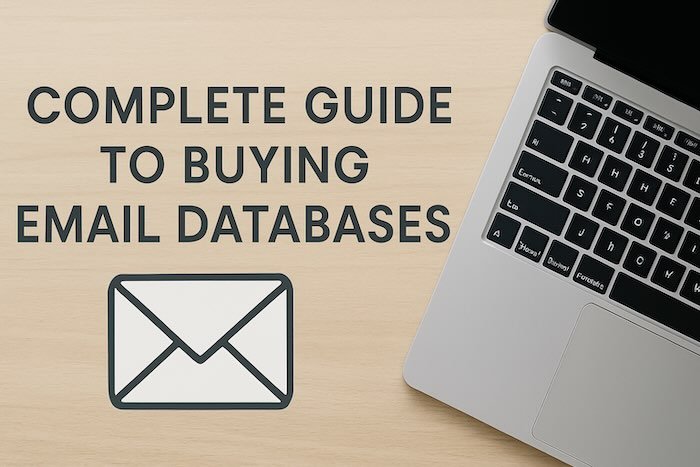Buying an email database is one strategy organizations use to expand their reach and improve advertising campaigns. Despite this, great care should be exercised when this process is undertaken.
When buying an email list database, think of your target users, study lawful requirements, select a good source of the email database, obtain quality data for emails, and verify and synchronize the emails for effective marketing efforts.
Ultimate Guide to Purchasing Email Databases
Progressing further towards buying email databases involves the following.
Understand Your Needs
Before buying an email database, you should have your specific goals. Ask yourself the following:
Target Audience: Who do you wish to target? Consider demographics like age, geolocation, industry, and interests.
Purpose: Is the purpose of product promotion, surveying, or establishing brand presence?
Scope: How large a database will you require to achieve your goals?
Setting such parameters allows you to narrow your research to databases within your target market.
Also Read: Which Email Marketing Service is the Best?
Research Legal and Ethical Guidelines
Buying and utilizing email lists are legal and ethical matters. Familiarize yourself with legislation like the CAN-SPAM Act in the US.
Consent: Make sure that contacts in the database are allowed to receive emails.
Opt-Out Mechanism: Give the recipients a simple means of opting out of future communications.
Data Protection: Process personal data securely to avoid data breaches.
Following these rules maintains your business’s reputation and avoids legal repercussions.
Find a Reputable Email Database Provider
Selecting the right provider is the key to obtaining quality data. Keep the following in mind when considering prospective vendors:
Reputation: Search for opinions and reviews from other companies.
Transparency: The provider must elucidate data sources and collection methods in detail.
Compliance: Ensure they comply with legal requirements and deliver databases with proper permission.
Take time to research providers to prevent headaches later on.
Also Read: Best Ways to Remove Duplicate Emails from Outlook
Evaluate the Database Quality
All databases are not equal. Test the quality by keeping the following in mind:
Accuracy: Are the email addresses correct and up-to-date?
Relevance: Does the data align with your target market’s requirements?
Completeness: Is there more information like names, phone numbers, and company information?
Quality data provides improved rates of participation and higher return on investment.
Learn the Pricing and Terms
Email databases can differ greatly in price. When considering pricing and terms:
Cost Structure: Is it a one-time fee or a subscription?
Usage Rights: Are there limitations on how you can utilize the data?
Refund Policy: Is there a refund policy in case the data does not meet your expectations?
Understanding these factors will assist you in making a well-informed financial decision.
Make Your Purchase
After you have chosen a provider and agreed to the terms, you can make the purchase. However, you should document all transactions and communications for future use.
Clean and Verify the Emails
Even with trusted providers, verifying the email addresses before sending a campaign is a good practice. Utilize email verification tools to:
Remove Duplicates: Remove duplicate entries to prevent redundancy.
Validate Addresses: Verify that all emails are active and properly formatted.
Identify Spam Traps: Identify and eliminate emails that might damage your sender’s reputation.
Database cleaning improves deliverability and open rates.
Integrate the Emails into Your System
Import the verified email list into your Customer Relationship Management (CRM) system or email marketing tool. Arrange the data efficiently by:
Segmentation: Divide contacts by demographics or behavior for precise campaigns.
Tagging: Mark contacts to monitor the source of acquisition and other such information.
Correct integration enables effective campaign management.
Maintain and Update Your Email List
An email list needs constant maintenance to work effectively.
Monitor Engagement: Monitor open and click-through rates to spot active subscribers.
Remove Inactive Contacts: Regularly clean up contacts that are not engaged within a set time.
Update Information: Update data to maintain alignment with changes in contact information.
Regular maintenance keeps your email marketing campaigns productive.
Also Read: How to Use Email Marketing for Lead Generation Successfully?
Benefits of Buying an Email Database
The following are the advantages of purchasing an email database:
- Instant Access to Contacts: Access potential buyers instantly without building a list.
- Saves Time and Effort: Obtain an instant-use list without manual email collection.
- Increase Your Market: Engage new clients and expand your business quicker.
- Increases Sales and Conversions: Increased leads translate to more opportunities to convert into customers.
- Affordable Advertising: Email campaigns are less costly than conventional advertising.
- Targeted Campaigns: Numerous databases include segmented data for improved targeting.
- Supports Business Growth: Facilitates startups and businesses to grow quicker.
- Improves Brand Recognition: More individuals get to know about your company.
- Boosts Engagement: Engage more individuals through email marketing.
Conclusion
Buying an email list databaserequires careful consideration of your needs, legal guidelines, and provider reputation. It offers benefits like instant access to contacts, saved time, and cost-effective marketing.
Evaluating database quality, pricing, and terms can help you make an informed decision. Regular maintenance and updates ensure the effectiveness of your email marketing efforts, leading to increased engagement, sales, and business growth.

